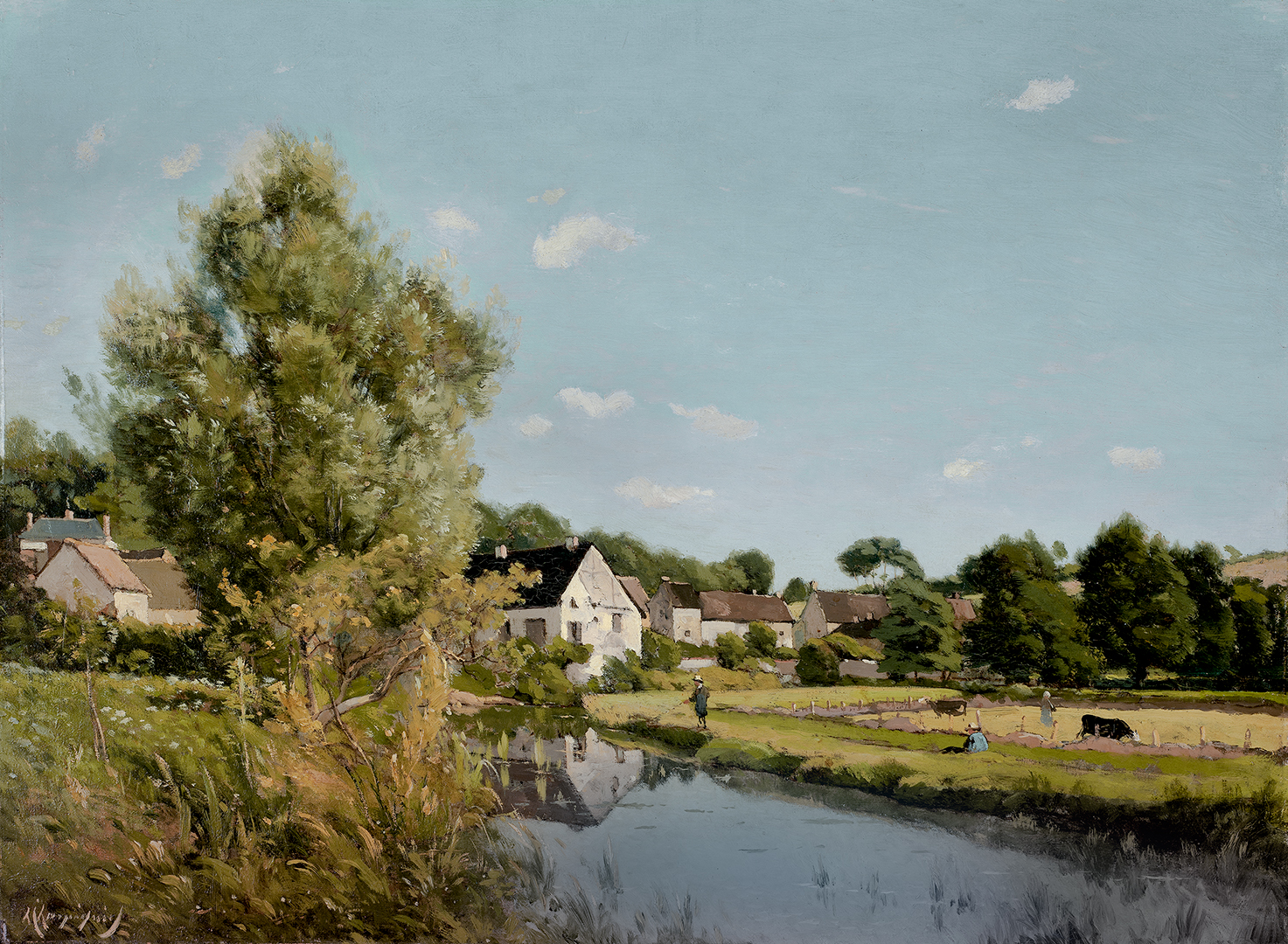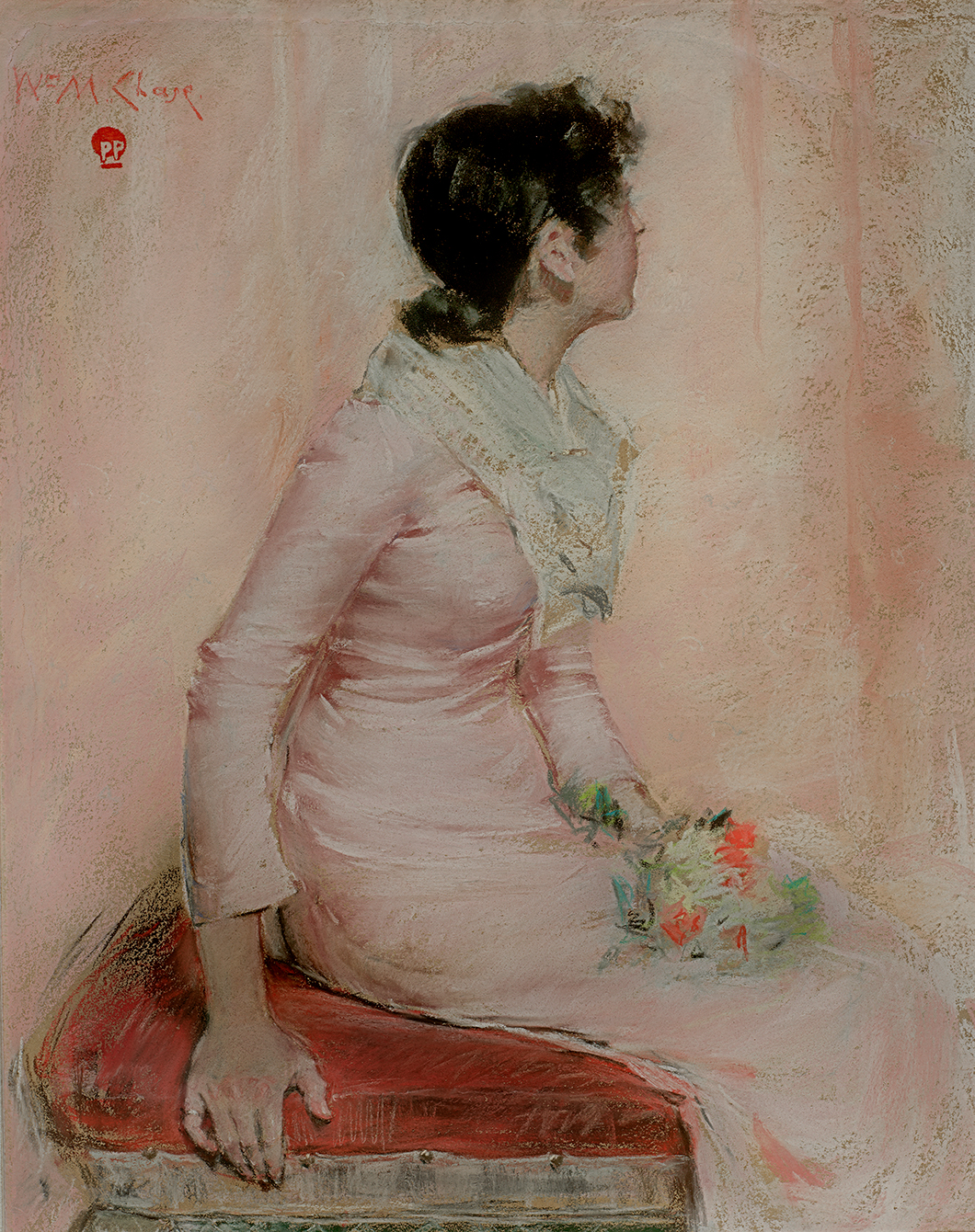Born in Philadelphia, Harrison studied with Thomas Eakins at the Philadelphia Sketch Club. He met the artist John Singer Sargent in 1875 and the two became friends; Sargent persuaded Harrison to come with him to Paris to continue his education. The young artist also studied under Emile-Auguste Carolus-Duran, Sargent’s own teacher, before entering the Ecole des Beaux-Arts. He would spend six years there learning his craft.
Harrison won recognition early. He exhibited his first work at the Paris Salon in 1881. Harrison traveled throughout the 1880s and did not return to the United States until 1891, when he settled with his wife Eleanor in Santa Barbara, California. After his wife’s death Harrison returned to the East Coast and exhibited at the National Academy of Design, the Pennsylvania Academy of Fine Arts, and with the Society of American Artists. He also sold illustrations to popular magazines such as Scribner’s, Harper’s, and the Atlantic Monthly.

Harpignies was the son of a family that made its fortune in sugar refining. Expected to enter the family business, he began his art career late, coming to Paris only in his mid-twenties to study with the landscape painter Jean-Alexis Achard. After traveling in Italy and Germany, Harpignies settled in Paris in 1852. He first exhibited at the Salon in 1853.
Like his good friend, the painter Jean-Leon Gérôme (1824-1904), and his former teacher, Achard, Harpignies focused on minute details in his paintings. He studied the landscapes of Jean-Baptiste-Camille Corot and the Barbizon painters: his luminous canvases showed rural scenes bathed in an even, diaphanous light. His contemporaries knew that Harpigniès had a botanical bent. The critic and novelist Anatole France called him the “Michelangelo of trees.”
Gérôme studied under the artist Paul Delaroche and at the Ecole des Beaux-Arts for three years prior to traveling to Rome in 1843. Gérôme debuted at the 1847 Salon. In 1863 Gérôme accepted a position as one of the three professors of fine art at the Ecole des Beaux-Arts, a position he would hold for the next 39 years.
Gérôme traveled to Egypt for the first time in 1856. He returned to Egypt six times in the next decades, and he made many Orientalist paintings of North African people, cities, animals, and landscapes. In the 1870s, Gérôme turned to sculpture, which preoccupied him for much of the rest of his career.
A fixture of the Paris art world, Gérôme decried the work of Edouard Manet, Claude Monet, and their friends, seeing in their new style of painting a rejection of all he had taught and created. As the Impressionists rose in popularity, Gérôme’s stock correspondingly fell. He remained, however, a sought-after and well-connected teacher—and an artist who was popular in America.
Diaz went to work at age 17 for a printer, and then for a manufacturer of porcelain. In his early twenties he copied paintings in the Louvre, teaching himself technique by mimicking the styles of the likes of Rembrandt van Rijn and Antonio da Correggio. At 31, he debuted at the Salon. Five years later, he settled in the village of Barbizon a little to the southeast of Paris.
Success began to follow Diaz when he settled on painting landscapes. The view of the Fontainebleau forest—one of many he created over the course of his career—that he showed at the Salon of 1844 won a third-class medal; the medals kept coming through the 1840s. Diaz received the Legion of Honor in 1851. After that, his paintings sold so well that he stopped exhibiting at the Salon. By the 1880s, American collectors with names like Morgan, Vanderbilt, Drexel, and Walters owned his work.
De Nittis was born in the village of Barletta, not far from Naples. Through his mid-twenties, de Nittis painted in the countryside around Naples. He went to Paris in 1867 and met Jean-Léon Gérôme (1824-1904) and Gérôme’s father-in-law, the art dealer Adolphe Goupil. De Nittis settled in Paris and, in 1869, exhibited for the first time at the Salon.
War broke out between France and Prussia in 1870, and de Nittis returned to Naples, coming back to Paris after the war and exhibiting at the Salon of 1872. In Paris, de Nittis was close to Degas, Edouard Manet, and Gustave Caillebotte; Degas invited him to participate in the first Impressionist exhibition in 1874. His works were successful at the annual Salon, and were purchased by collectors in France, England, and the United States. De Nittis was made a knight of the Legion of Honor in 1878. Like many artists of his time, de Nittis’ preferred method of work was to sketch outdoors and then complete his paintings in the studio.
De Madrazo came from a Spanish family of painters. His father, Federico, was his earliest teacher. He studied at the Royal Academy in Madrid and, after 1862, in Paris with the artist Léon Cogniet. De Madrazo exhibited regularly in the Paris Salon, winning a medal at the 1878 Universal Exposition. With his brother-in-law Mariano Fortuny, he embraced genre painting, turning out small, elegant paintings of beautiful women in sumptuous surroundings. In 1882, he and his friends—the artists Giuseppe de Nittis (1846-1884) and Alfred Stevens, and the gallery owner Georges Petit—co-founded the Exposition International de Peinture to gain more exposure for foreign artists working in Paris.
In the 1890s, de Madrazo traveled to New York and remained there for several years. He continued his acquaintance with the Haggins; when he remarried in 1899, he sent Louis and Blanche an announcement. De Madrazo’s portraits were popular in New York Society. He painted industrialist Cornelius Vanderbilt II, Gertrude Vanderbilt, and collector Archer Milton Huntington, among other luminaries.
“Monsieur Dasson, who owes his success and fortune to the famous carvers of the 18th century,” wrote the furniture scholar Edmond Bonnaffé in 1885, “writes history, not with a pen, but with the bronzes, marbles, tables… in his collections.”
Henri Dasson, the son of a shoemaker, was famous in the second half of the 19th century for his copies of 18th-century French furniture and household goods. He created desks, tables, and chests decorated in gilt bronze inspired by the style of Louis XIV, Louis XV, and Louis XVI. He was a member of the Legion of Honor in 1883. Dasson exhibited his works in the Universal Expositions of 1878 and 1889 in Paris as well as in other European expositions.
Jasper Francis Cropsey grew up on Staten Island, New York. He apprenticed at age 14 with the architect Joseph Trench. The young man took lessons from the English watercolorist Edward Maury; American painters William T. Ranney and William Sidney Mount encouraged his efforts. In 1843 Cropsey exhibited for the first time at the National Academy of Design. Though he was qualified as an architect, he began to support himself through his art and, in 1847, went to Europe for two years. Coming home, Cropsey set up a studio in New York.
His career blossomed through the rest of the 1860s and 1870s. The painter’s popularity faded as the grandeur of the Hudson River School gave way to a fashion for the moodier, more atmospheric paintings of the Barbizon School. But he continued to exhibit at the National Academy of Design and, from 1877, also at the American Society of Painters in Watercolor (later the American Watercolor Society).
Crane, the son of an amateur painter, was born in 1857 in New York City. When he was 17, he apprenticed for two years with an architect in Elizabeth, New Jersey. Crane learned draftsmanship there, the foundation of his skill as an artist. During a summer trip to the Catskills, the young man spent an afternoon with a painting class and was entranced.
Crane visited Europe first in 1878 and several times over the next five years. By 1888, Crane had settled in a studio at 106 West 55th Street in New York. For the next half century Crane would remain a key player in the New York art world.During the summer, Crane, like many of his fellow landscape painters, sketched in New England. Those sketches later served as the seed of his paintings—but only the seed.
Crane exhibited annually and received awards in exhibitions around the country, from Buffalo to San Francisco. He died at his home in Bronxville, New York, in October 1937.



